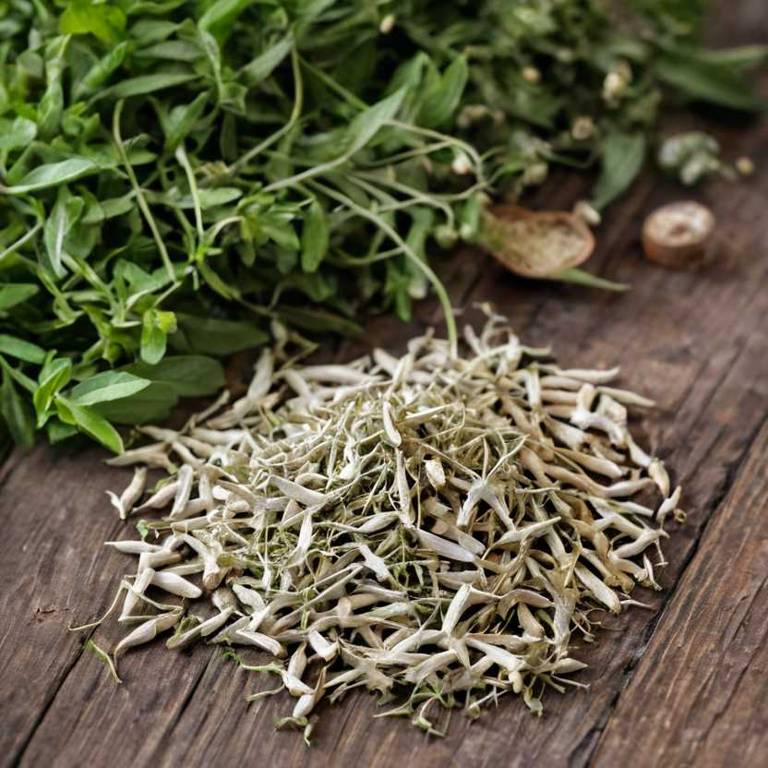Ashwagandha (Withania Somnifera)
Information Reliability Score: 5/10
This score reflects the overall reliability of the information presented in this article. It is based on the quality of scientific evidence, accuracy of sources, and the transparency of references related to Withania somnifera.

Ashwagandha, scientifically known as Withania somnifera, is a revered medicinal herb native to India, widely recognized as an adaptogen and a key component in Ayurvedic medicine.
It is commonly used to help the body manage stress, enhance vitality, and support overall well-being. Traditionally, Ashwagandha has been employed in Indian culture to treat anxiety, improve sleep, and boost energy levels, with its roots tracing back thousands of years. In modern wellness practices, it is increasingly utilized for its potential to reduce cortisol levels, enhance cognitive function, and support immune health.
One of its unique features is the presence of withanolides, rare compounds believed to contribute to its adaptogenic properties, along with its distinctive earthy, bitter taste that sets it apart from other herbs.
FREE CHECKLIST
The Only 10 Herbs You Need to Heal 90% of Common Ailments.

Table of Contents
Scientific and Botanical Profile
Ashwagandha, with botanical name Withania somnifera, is a well-known medicinal plant belonging to the Solanaceae family, commonly referred to as the nightshade family.
Native to regions such as India, Nepal, Bhutan, Bangladesh, Pakistan, Sri Lanka, and Afghanistan, it is also known by several common names including Indian Ginseng, Panchpharma, Panchphala, Withania, and Panchphalus. Morphologically, it is a small evergreen shrub that typically grows up to 1 to 2 meters in height, featuring simple, alternate leaves that are ovate to elliptic in shape and often have a hairy texture.
The plant produces yellow-orange flowers that give way to red, spherical berries containing small, black seeds, which are used in traditional Ayurvedic medicine for their adaptogenic and therapeutic properties.
History and Cultural Relevance
Ashwagandha was used for thousands of years in Ayurvedic medicine, one of the oldest holistic healing systems originating in India, where it is known as "the Indian ginseng.
" It has been traditionally revered for its ability to enhance vitality, reduce stress, and support overall well-being, making it a staple in Ayurvedic formulations for both physical and mental health. In various Indian cultures, Ashwagandha has played a role in rituals and ceremonies, often being used in purification rites and as an offering to deities, symbolizing strength and resilience. Today, its traditional remedies such as adaptogen formulations and herbal supplements continue to be widely used for managing anxiety, improving sleep, and boosting immune function.
Its enduring cultural relevance highlights the deep connection between ancient wisdom and modern health practices.
Chemical Composition and Nutritional Profile
Ashwagandha contains a variety of bioactive compounds, including alkaloids such as withanolides, flavonoids, essential oils, and terpenes, which contribute to its adaptogenic and therapeutic properties.
It is also rich in nutrients like vitamins C and E, iron, zinc, and magnesium, along with antioxidants that help combat oxidative stress. These compounds work synergistically to modulate the body's stress response by influencing the hypothalamic-pituitary-adrenal (HPA) axis and reducing cortisol levels. The plant's active constituents also support neuroprotection, immune function, and cellular health through anti-inflammatory and antioxidant mechanisms.
Overall, Ashwagandha's unique chemical composition and nutritional profile make it a valuable herb in traditional and modern holistic medicine.
Medicinal Properties and Health Benefits
Withania somnifera has been extensively studied for its diverse medicinal properties and wide-ranging health benefits, primarily due to its active alkaloid compounds, such as withanolides, which exhibit adaptogenic, anti-inflammatory, and neuroprotective effects.
It supports multiple body systems, including the nervous, immune, and endocrine systems, by reducing stress, enhancing cognitive function, and regulating hormonal balance. Compared to similar herbs like ashwagandha (which is the same plant), it is often used interchangeably, but withania somnifera is noted for its higher potency and broader therapeutic applications, particularly in managing chronic stress and anxiety. Its unique ability to modulate the body's stress response makes it more effective than many other adaptogens in promoting overall well-being.
Additionally, it has shown potential in supporting metabolic health and may aid in the management of conditions like diabetes and cancer, offering a holistic approach to health maintenance.
Discover the 10 best health benefits of Ashwagandha.
Forms, Preparation and Usage
Withania somnifera has a variety of forms available, including fresh and dried roots, tinctures, powders, essential oils, and capsules, each offering different methods of preparation and application.
It can be prepared as a tea by steeping dried roots in hot water, or as a decoction by simmering for a longer period to extract more potent compounds. Topical applications include the use of creams or oils for localized relief, while the powder form can be mixed with water or other substances for internal consumption. For adults, a typical dosage is 300-600 mg of standardized extract per day, divided into two or three doses, while children should only use it under medical supervision if deemed safe.
It is recommended to use withania somnifera for short durations, typically no longer than a few weeks, to avoid potential side effects and to monitor individual response.
Safety, Side Effects and Contraindications
Withania somnifera can be used as a medicinal plant for its potential therapeutic effects, but it is important to consider its safety profile.
It may cause side effects such as gastrointestinal discomfort, nausea, and allergic reactions, especially at high doses. Withania somnifera may interact with certain medications, including sedatives, antidepressants, and blood pressure medications, potentially altering their effects. It is contraindicated during pregnancy and breastfeeding due to limited safety data and potential risks to the fetus or infant.
Individuals with chronic illnesses should consult a healthcare provider before use, and safety tips include starting with low doses and monitoring for adverse reactions.
Growing, Harvesting and Storage
Withania somnifera grows best in well-drained, loamy soil that is rich in organic matter and has a slightly alkaline pH, preferring full sun to partial shade.
It thrives in warm climates with temperatures between 20°C and 30°C and requires moderate irrigation, allowing the soil to dry slightly between waterings. Regular weeding and mulching help control weeds and retain soil moisture, while periodic pruning promotes bushier growth and enhances yield. Harvesting is best done in the early morning or late evening to avoid sun stress, with the roots and stems collected when the plant is mature, typically after 6 to 12 months of growth.
For optimal potency, the harvested parts should be thoroughly dried in the shade, stored in airtight containers in a cool, dry place, or refrigerated to maintain their medicinal properties.